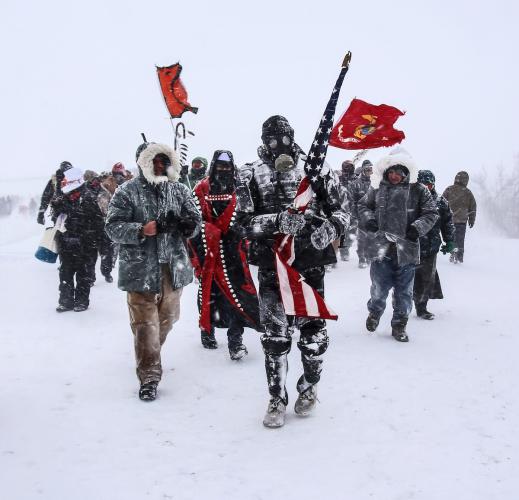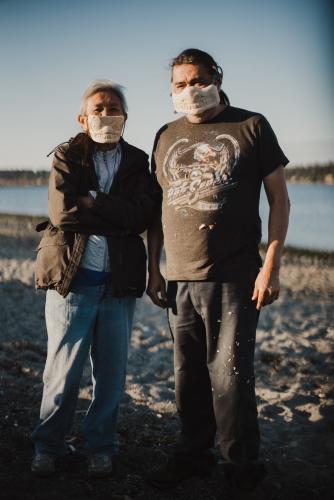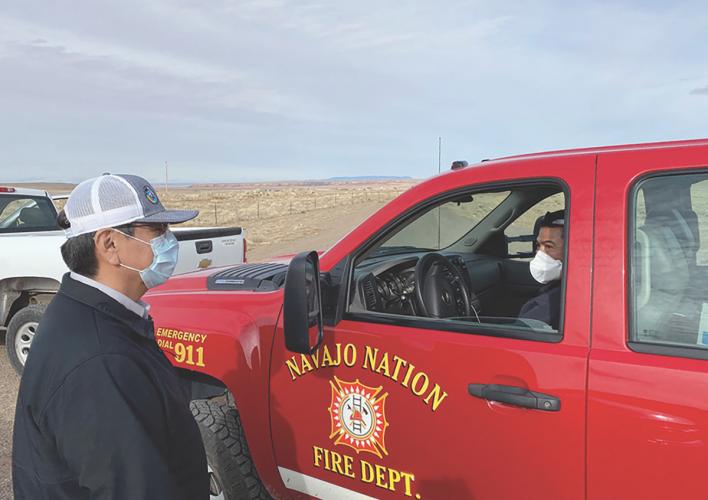Since January, we have read about and watched on television the massive devastation wrought by a disease as it spread from nation to nation. COVID-19—caused by a novel coronavirus that was first traced to a live animal market in Wuhan, China—only became known to the public through the brave pleas of doctors for urgent action and the journalists who were eventually able to convey their messages, even though the outbreak originated in a country that censors news.
In the months of self-quarantining that followed, we have depended upon the media’s daily updates that digest the complex, rapidly changing information. Reporters and other news personnel risked exposure to this deadly virus to bring us breaking news from medical personnel, first responders and others on the front lines. Media professionals were among the more than 5 million infected worldwide—and the hundreds of thousands who consequently died.
This issue of American Indian magazine is a tribute to all those in the media profession, particularly Indigenous journalists and photojournalists who are closest to the issues impacting Indigenous peoples. During the past few years, Indigenous affairs that had been virtually absent in mainstream media have once again been brought into the light. In part, this is due to the hard work of Indigenous journalists, some of which has inspired art and some of which has become art.
News as Art
The American Indian Movement that activists founded in 1968 and the organization’s participation in the occupation of Alcatraz the following year brought Native American civil rights to the attention of mainstream media. But that attention waned in the decades that followed. Many people say the 2016 protests against the Dakota Access Pipeline running next to the Standing Rock Indian Reservation in North and South Dakota united Native Nations as never before and gathered supporters from around the world, reigniting their passion to speak on behalf of Indigenous affairs. An iconic photo born of these protests (“December 5, 2016/Standing Rock,” right) became a symbol for those fighting for Indigenous civil rights.
Tlingit photographer Zoe Urness wanted to join the protestors at Standing Rock, but, she says, “I didn’t want to go there to just take up space.” She decided she could contribute best by documenting this historic event. From a bridge, she was warming her freezing digital camera beneath her coat when she saw the protestors marching toward her. She ran down through the deep snow to snap a photo. Just after she took the shot, she stumbled and fell into a ravine. When she looked at the image through the preview window, she realized she had captured a unique moment in time that encapsulated the spirit of the protest: U.S. Marine veterans were leading the protestors in a perfect V formation, as if into combat. One of them wore a red Tlingit robe and another was waving her tribe’s flag. Urness says she began to cry: “It was fate.” Her award-winning photo has been displayed in several museums and was even nominated for a Pulitzer Prize.
Since the Standing Rock protests, other Indigenous affairs have gained national media attention and inspired artists to create works that heal. The tragedy of Native women being raped, abducted and murdered, known about for decades, finally began to be acknowledged in the mainstream press as demonstrators in red dresses were seen across the United States and Canada. The ongoing crisis prompted Métis artist Jaime Black to launch the REDress Project, a series of red dress installations, one of which was displayed outside the National Museum of the American Indian in 2019. The dresses eerily floating in the wind symbolize those who are gone.
This year, people throughout the world have turned to all forms of art—paintings, drawings, music, dance, sculpture and more— to cope with the depressing fear and isolation caused by the coronavirus. Tsawout First Nation Howard La Fortune in Victoria, British Columbia, has been a wood carver for the past 40 years. He carved a bear mask out of yellow cedar that emulates the masks everyone is now having to wear for protection from the coronavirus because “a bear symbolizes strength, and that is what we need about now to get through all this.” After his mask won first place in First American Art magazine’s virtual exhibition of COVID-19-inspired masks called “Masked Heroes,” he received requests for several more. Even though La Fortune’s masks aren’t for medical protection, he is writing “COVID-19 Pandemic 2020” on each of them because, he says, his customers “want to remember.”
For Native Communities
Stories, whether told through words, images or art, have immense power to move people and cross cultural boundaries. However, Indigenous peoples are not always in control of their own narratives. That was the inspiration behind NMAI’s new photo exhibitions for “Developing Stories: Native Photographers in the Field,” which are featured in this issue and online at AmericanIndian.si.edu/developingstories. NMAI’s Cécile Ganteaume, who curated the exhibitions, says the museum wished to collaborate with Native journalists in the telling of their own stories.
Ganteaume and other NMAI staff worked with Tristan Ahtone (Kiowa), president of the Native American Journalists Association, and John Smock, the director of photojournalism at the Craig Newmark Graduate School of Journalism at the City University of New York, to select two projects that stood out from the 12 that photojournalists submitted. While they cover vastly different topics, both photo essays tell “unique, contemporary stories not well known to non-Native audiences,” says Ganteaume.
For the first, “The Genízaro Pueblo of Abiquiú,” Diné and Ho-Chunk photojournalist Russel Albert Daniels lived among the residents of this small community during the fall of 2019. These Spanish and American Indian descendants have lived in this pueblo in northwest New Mexico for more than 250 years. Smock says that Daniels’s work has “a timeless quality.” His black-and-white portraits, Ganteaume says, “just have a way of getting directly to people’s characters.” In "Photography as Medicine" in this issue, Daniels talks about his experience living among the Genízaro people and his own journey to becoming a photographer.
In "Being Native" in this issue, Salish and Kootenai photojournalist Tailyr Irvine talks about the challenges of interviewing her family and friends on her Flathead Indian Reservation in western Montana for her photo essay, “Reservation Mathematics: Navigating Love in Native America.” This exhibition dives into how U.S. government regulations that use the concept of American Indians’ so-called “blood quantum”—or amount of tribal affiliation in a person’s ancestry—to determine tribal enrollment eligibility impacts their choice of partners. Ahtone says that while this is an issue known to every Native American, “putting faces to the issue is important.” Irvine’s work, he says, puts “a human touch to it.”
Journalists and photojournalists are professional storytellers who objectively pursue and report the facts. However, everyone’s life experiences invariably shape what one sees and hears. Smock says the field of photojournalism is “reinventing itself” to respond to the growing need to give members of traditionally underrepresented groups “more of a voice in how their story is told.” Ahtone says, “mainstream media tends to be reporting about communities rather than reporting for communities.” On the other hand, as Cherokee Nation journalist Bryan Pollard writes in “More Than News” in this issue, Indigenous media “is an engaged partner, serving its community and its audience with depth, clarity and perspective.
Journalism at Work
Given the great potential of people to be infected by the coronavirus that “social distancing” may continue for some time, Indigenous journalists who live within their communities are needed more than ever. “We are telling the stories that no other publications can tell,” says Navajo Times reporter Arlyssa Becenti. “The national media focuses on the negative. We are providing positive stories—stories about who has survived and how we are all pitching in to help each other and take care of our elders.”
Yet journalists on the ground may not be able to do business as usual. Becenti’s normal beat is the tribal government, yet as the Navajo Nation has not been gathering to hold council meetings, she is almost entirely covering the impacts of the virus. She also can no longer always talk face-to-face with those she is interviewing. “In this community, you introduce yourself because we are all relatives. You tell them your clan and shake hands,” she says. “The phone is not personal.”
While restaurants, farmers and other producers have been hit hard by the economic downfall that followed in the wake of the virus’s outbreak, other casualties have been media outlets and even freedom of the press in some countries. After their advertising revenue suddenly plummeted, some newspapers furloughed staff and other small community publications folded. As the Navajo Times is normally distributed through local businesses that closed during the outbreak, Editor Duane Beyal says that while the newspaper is prepared to weather the storm, “We’re suffering a big hit in circulation.” On a broader scale, the 2020 World Press Freedom Index recently reported that some authoritarian nations such as China also may be taking advantage of people’s fear of the virus to take further controls and hamper press freedoms.
Whether media is covering a worldwide crisis or a local school board meeting, every well-researched news story has at least one journalist behind it. Journalism is a critical cog in the functioning of a society, and the contributions of Indigenous journalists are not only essential but also often inspirational. Whatever news we read, listen to or watch from the safety of our homes, we must value our media professionals and remember the effort they undertake to bring the news to us. The editors of American Indian magazine thank all our media colleagues for their work and wish them the strength to continue the fight, whether they are behind the scenes, at a desk or on the front lines.



